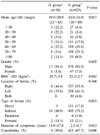Abstract
Purpose
Incarcerated inguinal hernia may have very unusual hernial sac contents. In this study we aim to present clinical characteristics about incarcerated inguinal hernia of the greater omentum.
Methods
We retrospectively analyzed hospital records of 643 adult patients who underwent inguinal hernia repair from November 2001 to January 2009. The age, sex, location, type, symptom duration, body mass index (BMI), comorbidity, type of anesthesia, operative time, postoperative hospital stay and complications were reviewed.
Results
Of the 643 cases, 18 cases were omental incarcerated inguinal hernia group (O group). Seventeen in 18 cases of O group were male patient (NS). In O group, 16 cases were indirect type and 2 cases were femoral type (P=0.021). Mean age was younger in O group than in non-omental incarcerated inguinal hernia group (N group) (P=0.017). Duration of symptom was longer (P=0.013), and body mass index (BMI) was larger in O group (P=0.042). Operative time was longer in O group than in N group (P=0.006).
Conclusion
The patients with omental incarcerated inguinal hernia mostly had long durations of protruding mass without pain. In these patients, operation was relatively difficult due to severe adhesion between the hernial sac and greater omentum. In addition, operative time took approximately 10 minutes longer. Therefore, general and spinal anesthesia is more feasible than local anesthesia.
Figures and Tables
Table 1
Comparison of clinical characteristics between groups with and without omental incarceration

References
1. Hjaltason E. Incarcerated hernia. Acta Chir Scand. 1981. 147:263–267.
2. Brasso K, Londal Nielsen K, Christiansen J. Long-term results of surgery for incarcerated groin hernia. Acta Chir Scand. 1989. 155:583–585.
3. Alvarez JA, Baldonedo RF, Bear IG, Solis JA, Alvarez P, Jorge JI. Incarcerated groin hernias in adults: presentation and outcome. Hernia. 2004. 8:121–126.
4. Mhoon JM, Redman JF, Siebert JJ. Scrotal enlargement in boys with a history of scrotal trauma: two unusual findings. South Med J. 2002. 95:251–252.
5. Lee KN, Sung KT, Hong KU, Lee YC, Park YC. A clinical review of inguinal hernia in the aged, 50 years and over. J Korean Surg Soc. 1982. 24:1217–1224.
6. Milic DJ, Rajkovic MM, Pejcic VD. Primary omental liposarcoma presenting as an incarcerated inguinal hernia. Hernia. 2005. 9:88–89.
7. Lam KY, Lo CY, Lee M, Chan KW. Omental fibromatosis presenting as an incarcerated inguinal hernia. Aust N Z J Surg. 1999. 69:322–324.
8. Oishi SN, Page CP, Schwesinger WH. Complicated presentations of groin hernias. Am J Surg. 1991. 162:568–570.
9. Rai S, Chandra SS, Smile SR. A study of the risk of strangulation and obstruction in groin hernias. Aust N Z J Surg. 1998. 68:650–654.




 PDF
PDF ePub
ePub Citation
Citation Print
Print




 XML Download
XML Download